Cambria is a name for Wales, being the Latinised form of the Welsh name for the country, Cymru. The term was not in use during the Roman period. It emerged later, in the medieval period, after the Anglo-Saxon settlement of much of Britain led to a territorial distinction between the new Anglo-Saxon kingdoms and the remaining Celtic British kingdoms. Latin being the primary language of scholarship in Western Christendom, writers needed a term to refer to the Celtic British territory and coined Cambria based on the Welsh name for it.

Cadwaladr ap Cadwallon was king of Gwynedd in Wales from around 655 to 682 AD. Two devastating plagues happened during his reign, one in 664 and the other in 682; he himself was a victim of the second. Little else is known of his reign.
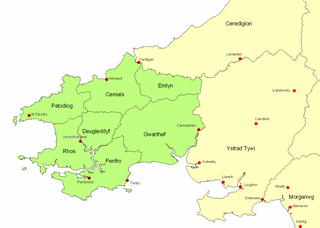
Vortiporius or Vortipor was a king of Dyfed in the early to mid-6th century. He ruled over an area approximately corresponding to modern Pembrokeshire, Wales. Records from this era are scant, and virtually nothing is known of him or his kingdom. The only contemporary information about Vortiporius comes from the Welsh ecclesiastic Gildas, in a highly allegorical condemnation from his De Excidio et Conquestu Britanniae. At the time the work was written, Gildas says that Vortiporius was king of Dyfed, that he was grey with age, that his wife had died, and that he had at least one daughter.
Cadfan ap Iago was King of Gwynedd. Little is known of the history of Gwynedd from this period, and information about Cadfan and his reign is minimal.
Iago ap Beli was King of Gwynedd. Little is known of him or his kingdom from this early era, with only a few anecdotal mentions of him in historical documents.
Beli ap Rhun was King of Gwynedd. Nothing is known of the person, and his name is known only from Welsh genealogies, which confirm that he had at least two sons. He succeeded his father Rhun ap Maelgwn as king, and was in turn succeeded by his son Iago. Beli was either the father or grandfather of Saint Edeyrn.
Rhun ap Maelgwn Gwynedd, also known as Rhun Hir ap Maelgwn Gwynedd, sometimes spelt as 'Rhûn', was King of Gwynedd. He came to the throne on the death of his father, King Maelgwn Gwynedd. There are no historical records of his reign in this early age. A story preserved in both the Venedotian Code and an elegy by Taliesin says that he waged a war against Rhydderch Hael of Alt Clut and the kings of Gododdin or Manaw Gododdin. The small scattered settlement of Caerhun in the Conwy valley is said to be named for him, though without strong authority. Rhun also appears in several medieval literary stories, as well as in the Welsh Triads. His wife was Perwyr ferch Rhûn "Ryfeddfawr" and their son was Beli ap Rhun "Hîr".
Idwal Iwrch, or Idwal ap Cadwaladr, is a figure in the genealogies of the kings of Gwynedd. He was the son of King Cadwaladr ap Cadwallon and the father of King Rhodri Molwynog. William Wynne places Cynan Dindaethwy as his son, but other sources have Cynan as the son of Rhodri. The records of this era are scanty, and Idwal's name appears only in the pedigrees of later kings and in a prophecy found in two 14th-century Welsh manuscripts, which says that he will succeed his father Cadwaladr as king.
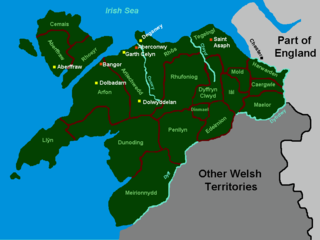
Rhodri Molwynog, also known as Rhodri ap Idwal was an 8th-century king of Gwynedd. He was listed as a King of the Britons by the Annals of Wales.

Caradog ap Meirion was an 8th-century king of Gwynedd in northwest Wales.

Cynan Dindaethwy or Cynan ap Rhodri was a king of Gwynedd in Wales in the Early Middle Ages. Cynan was the son of Rhodri Molwynog and ascended to the throne of Gwynedd upon the death of King Caradog ap Meirion in 798. His epithet refers to the commote of Dindaethwy in the cantref Rhosyr. Unlike later kings of Gwynedd, usually resident at Aberffraw in western Anglesey, Cynan maintained his court at Llanfaes on the southeastern coast. Cynan's reign was marked by a destructive dynastic power struggle with a rival named Hywel, usually supposed to be his brother.
Merfyn Frych, also known as Merfyn ap Gwriad and Merfyn Camwri, was King of Gwynedd from around 825 to 844, the first of its kings known not to have descended from the male line of Cunedda.

Hywel ap Rhodri Molwynog as he was improperly called due to lack of knowledge of the genealogies by men like John Edward Lloyd, but in fact was Hywel ap Caradog was King of Gwynedd. He rose to power following a destructive dynastic struggle in which he deposed his cousin, King Cynan Dindaethwy ap Rhodri. During Hywel's reign Gwynedd's power was largely confined to Anglesey. It was a time of substantial territorial loss to Mercia.
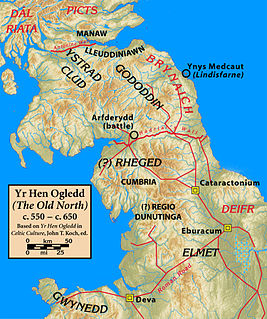
Yr Hen Ogledd, in English the Old North, is the historical region which is now Northern England and the southern Scottish Lowlands that was inhabited by the Brittonic people of sub-Roman Britain in the Early Middle Ages. Its population spoke a variety of the Brittonic language known as Cumbric which is closely related to, if not a dialect of Old Welsh. The people of Wales and the Hen Ogledd considered themselves to be one people and both were referred to as Cymry ('fellow-countrymen') from the Brittonic word combrogi. The Hen Ogledd was distinct from the parts of North Britain inhabited by the Picts, Anglo-Saxons, and Scoti.
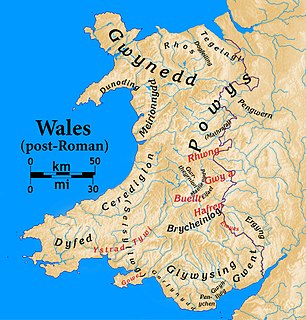
Wales in the early Middle Ages covers the time between the Roman departure from Wales c. 383 and the rise of Merfyn Frych to the throne of Gwynedd c. 825. In that time there was a gradual consolidation of power into increasingly hierarchical kingdoms. The end of the early Middle Ages was the time that the Welsh language transitioned from the Primitive Welsh spoken throughout the era into Old Welsh, and the time when the modern England–Wales border would take its near-final form, a line broadly followed by Offa's Dyke, a late eighth-century earthwork. Successful unification into something recognisable as a Welsh state would come in the next era under the descendants of Merfyn Frych.

The Roman era in the area of modern Wales began in 48 AD, with a military invasion by the imperial governor of Roman Britain. The conquest was completed by 78 AD, and Roman rule endured until the region was abandoned in 383 AD.
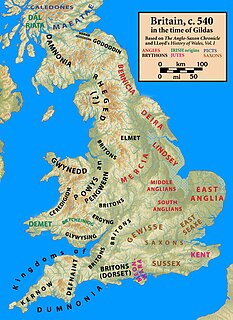
Manaw Gododdin was the narrow coastal region on the south side of the Firth of Forth, part of the Brythonic-speaking Kingdom of Gododdin in the post-Roman Era. It is notable as the homeland of Cunedda prior to his conquest of North Wales, and as the homeland of the heroic warriors in the literary epic Y Gododdin. Pressed by the Picts expanding southward and the Northumbrians expanding northward, it was permanently destroyed in the 7th century and its territory absorbed into the then-ascendant Kingdom of Northumbria.

Aeron was a kingdom of the Brythonic-speaking Hen Ogledd, presumed to have been located in the region of the River Ayr in what is now southwestern Scotland. It existed during the post-Roman era, perhaps earlier, and disappeared before or during the 7th-century conquest of the region by the ascendant Kingdom of Northumbria.
This article describes the etymology of Wales, a country that is today a part of the United Kingdom.

This is a timeline of Welsh history, comprising important legal and territorial changes, and political events in Wales.







